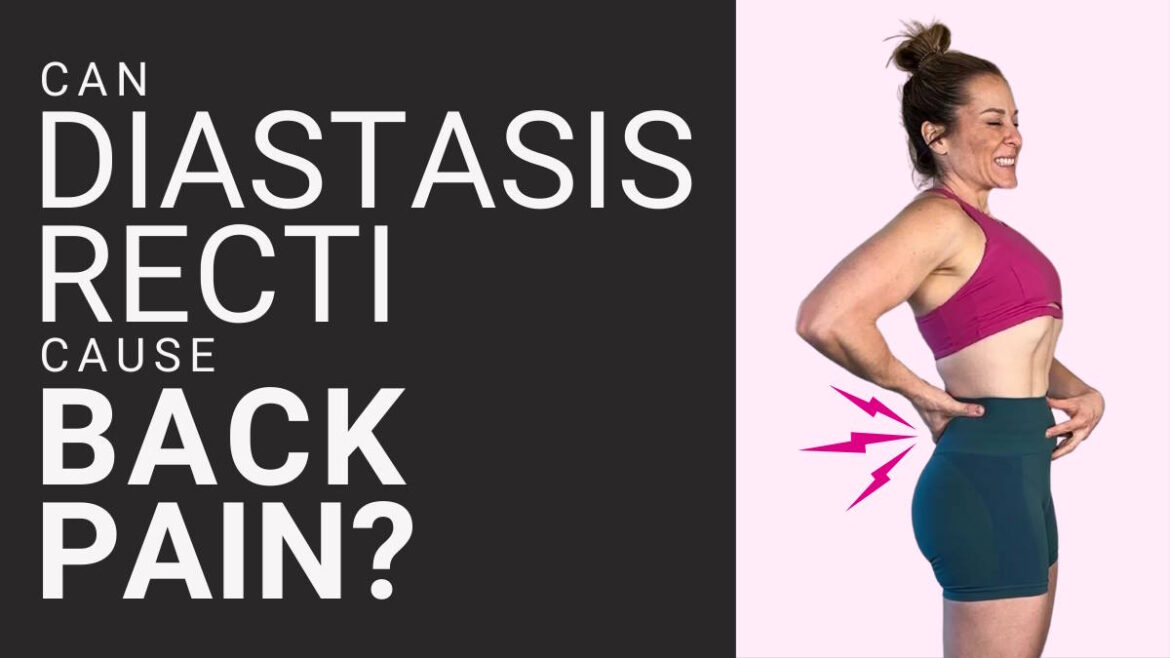Back pain is a common symptom of diastasis recti, even though not everyone who has it does. Back pain can be extremely uncomfortable given the demands of being a mom. Mom life requires constant lifting. Your core is necessary to support your back while doing anything from picking up a car seat to carrying a toddler through the zoo or bringing in the groceries all at once.

Diastasis recti symptoms include a host of common physical complaints, and lower back pain is one of them.
Diastasis recti, or abdominal wall separation, most often occurs when the growing fetus puts pressure on the linea alba, the connective tissue that runs down the midline of the abdomen. When the abdominal wall muscles separate, we lose support in the front and center of the body, compromising the physical structure of our core and posture. This shifts chronic muscle recruitment into a compensation pattern that puts stress and strain on our back muscles, which tend to become overly tight along with the hamstrings, leaving us in pain. For many women, diastasis recti does not spontaneously resolve itself after childbirth, and can result in diastasis recti back pain for months or years if not resolved.
How to Fix Diastasis Recti Back Pain
As a new mother or experienced parent, dealing with back pain is miserable to begin with, but with diastasis recti, it can completely disrupt your life. It’s nearly impossible to go a moment without using our core muscles, from lifting, feeding, and carrying a newborn or toddler to lugging around car seats, strollers, and large bags, to diaper changes and the countless other duties that come with parenthood. Diastasis recti weakens our abdominal muscles, so our back muscles must bear the brunt of all the lifting.
You don’t have to endure diastasis recti back pain, which is good news. In fact, this is the diastasis recti symptom that heals the most quickly. The solution is EMbody Core Compressions.
Core Compressions, a method created to therapeutically activate the transverse abdominis (your deepest abdominal muscle), in proper coordination with the diaphragm and pelvic floor, form the basis of every Every Mother workout. I’ve discovered that my clients’ diastasis recti back pain dramatically improves within 3–4 days of starting Core Compressions, frequently going away entirely in less than a week. This is due to the effectiveness with which this muscle engagement reduces chronic tension and muscle imbalances while restoring strength, form, and function. The best part is that the body internalizes healthier ways to move, rest, and distribute the workload of daily life. This allows the tissues to heal while the body learns new movement and muscle recruitment patterns.
In order to relieve diastasis recti back pain, the tabletop position of Core Compressions is particularly beneficial. Keep reading for step by step instructions.
How to perform Core Compressions in tabletop position:
- Lower yourself onto your hands and knees. Put your hands in fists with the palms facing each other if you experience any wrist pain or carpal tunnel syndrome.
- Before starting the exercise, take a few full, diaphragmatic breaths. With each breath, let the torso widen and the belly descend; on the exhale, draw the belly all the way up into the spine, keeping the back flat. This keeps the back in a neutral position and enables the back muscles to gradually release.
- Make sure to let your shoulders drop and lift your eyes a few feet in front of you.
- Squeeze and lift your abdominal muscles and pelvic floor up toward the spine in a controlled, “tight-tighter” muscle contraction. Maintaining a flat back, soften the belly as you inhale more slowly. As you relax the muscles, permit a natural inhalation to take place. Continue doing Core Compressions for 1-2 minutes, intentionally exhaling after each core contraction. Rest, and repeat for 5 sets.
Visit the Foundations library at Every Mother for in-depth video coaching on the nuances of performing 2-Tier Core Compressions, including when and how to incorporate the breath and the pelvic floor. Our full-body workouts include a variety of back mobility exercises, global strengthening exercises, and gentle stretches to restore muscle balance and encourage healthy posture, in addition to Core Compressions, which on their own can eliminate diastasis recti symptoms (including back pain) within days.
By Leah Keller, Creator of the EMbody Program™. Learn more about Leah here. .
FAQ
What does diastasis recti back pain feel like?
Diastasis recti is not painful. Although some of the diastasis’s side effects may cause pain, the ab separation itself is painless. When performing once simple tasks, like lifting a laundry basket, you might experience weakness in your core.
Will fixing diastasis recti help with back pain?
Given this established anatomic relationship, studies have linked the correction of diastasis with a reduction in chronic back pain; this connection has been made possible by the stabilization of the spine that follows plication.
Can abdominal separation cause back pain?
Lower back pain may also occur if you have abdominal separation. This is because your abdominal muscles also support your back. These muscles don’t function as well when they are stretched and dispersed. People with abdominal separation can also have pelvic floor issues.
Why does diastasis recti cause lower back pain?
Background: Diastasis of the rectus abdominis (DRA), a poor coordination of the abdominal muscles that stabilize the spine, may be a factor in the development of chronic low back pain (LBP).
Back Pain and Diastasis Recti- Julie Tupler, RN
Reference:
https://every-mother.com/empower/diastasis-recti-symptoms-lower-back-pain-relief
https://www.healthypostnatalbody.com/blog/diastasis-recti-lower-back-pain/
